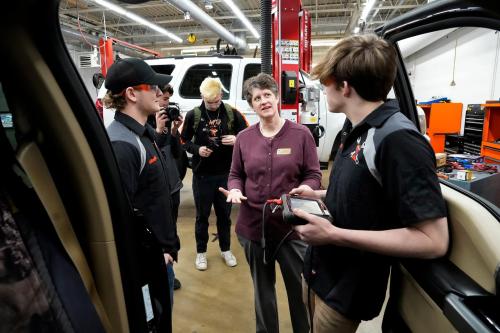The academic case for clusters (mounted by the likes of Michael Porter and others) already exists. The policy case (frequently made by us in Metro Program papers and on these pages) also exists. Now, the business case for cluster strategies and federal and state cluster policies has been gaining prominence, and that is what was recently asserted really powerfully by Eli Lilly and Co. President and CEO John Lechleiter.
At a major event on innovation clusters last month, Dr. Lechleiter delivered a strong address explaining how his Fortune 500 firm benefits from actively supporting and engaging in the vibrant, 1,600-company strong and growing life sciences cluster in its headquarters state of Indiana. Indeed, Lilly was one of the lead initiators of the statewide BioCrossroads cluster initiative that has successfully fostered connections between research institutions, corporations, government, and philanthropy to provide capital and business development assistance to entrepreneurs and form new enterprises, like a health information exchange and an orthopedics hub, to advance particular cluster priorities.
So, what’s in all this for Lilly’s bottom-line?
Dr. Lechleiter’s noted in his keynote speech that “the life sciences cluster strategy dovetails perfectly with [Lilly’s] own strategy as an innovation-based pharmaceutical company.” Specifically, in his own words, engagement with a regional innovation cluster across the state and concentrated in Indianapolis has helped Lilly:
- Adopt a 21st century business model: “More and more of the pieces [of Lilly’s value chain] are linked through partnerships, alliances, and other relationships and transactions rather than always through outright ownership.”
- Connect to new breakthroughs and opportunities: “A well-developed [fully integrated pharmaceutical network] allows us to cast a wider net for ideas, for molecules, for talent, and for resources. . . Lilly is part of a growing web of collaboration in the life sciences, expanding our network of drug discovery and development as well as manufacturing in our home state.”
- Become more nimble and adaptable: “As a result [of selling certain assets to other cluster actors] Lilly is a more flexible company, able to tap the capabilities of partners who specialize in the services they provide us. Further, by unlocking what had been internal Lilly assets and allowing them to serve additional clients, [these] transactions open the door to additional growth at these [assets], leading to increased employment and broader life sciences capabilities in the region.”
- Attract talent: “Researchers don’t actually live in cyberspace . . . They benefit from having a wide range of career opportunities in their field, right where they live. They still value opportunities for face-to-face interaction with others who do the same kind of work they do. So it’s important to us to have a vibrant life sciences community in our state if we’re to continue to recruit and retain the best talent.”
Other speakers last month, including Jason Furman of the National Economic Council, provided important affirmations of the cluster paradigm from multiple perspectives. Furman’s remarks, for example, may have been the highest-level acknowledgement of the economic centrality of regional economies ever, as we recently noted. And yet, it was equally important to hear a major U.S. corporate executive placing clusters and other regional dynamics and policy right alongside the more typical big business agenda items of tax, trade, and education reforms as a way to enhance American innovation and growth. In this regard, Lechleiter’s framing was so seemingly obvious and tangible that it made the regional basis of economic activity seem not a contestable proposition, but a simple economic fact. Which makes us wonder what other titans of business will soon make the same case.






Commentary
The Business Case for Clusters
October 7, 2010